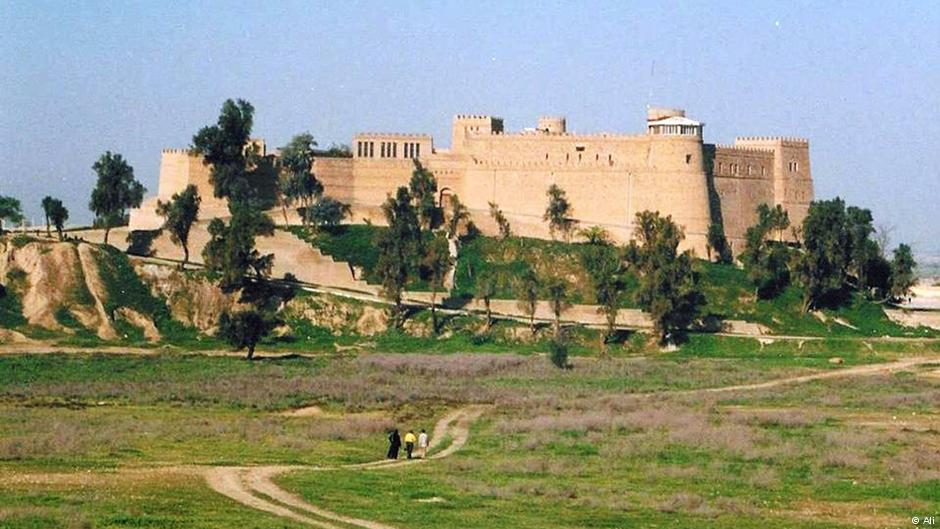The cradle of civilisation

Jiroft, a fertile plain located 230 kilometres south of the city of Kerman, is now reminiscent of a large piece of Swiss cheese or a gigantic molehill after thieves looted the ancient tombs there.
A photograph in the exhibition "Iran. Ancient Culture Between Water and Desert" in Bonn's Bundeskunsthalle museum shows the extent of the devastation. The thieves planned to sell their valuable plunder at auctions in the West. At the last minute, however, police succeeded in arresting them and securing the cultural relics.
They are now making their debut outside Iran for the very first time. The part of the collection on show in Bonn includes clay statues of praying men and women, terracotta figurines, gold jewellery, jars, vases and other vessels made of chlorite, alabaster and soapstone.
Wild animals and mythical creatures
The richly decorated artefacts provide a great deal of information about the daily life of the inhabitants of southeastern Iran during the Bronze Age, as well as their beliefs and myths. Scenes of combat and mythical heroes wrestling with animals of prey are recurring motifs on the vessels. On one of them, a muscular man is holding two leopards in the air by their tails. On another, a river seems to be flowing out of the foreheads of water buffalos, while another arises out of the coils of a snake.

"These are divine beings doing superhuman things. It's all about subjugating nature's wild forces," explains curator Barbara Helwing, who worked for the German Archaeological Institute in Iran until 2007. She adds with a chuckle, "Nowadays, Iranians use the image of this muscle man to promote their fitness studios."
In 2003, Iran made an effort to retrieve the objects stolen from the plain of Jiroft, recounts Helwing. "What we're exhibiting comes from the first confiscated collection of objects found in Jiroft. They were recovered from Sothebys and other auction houses."
How the region was settled
Numerous multimedia stations provide visitors with all kinds of information about Iran. The region's geography is determined by the meeting of several tectonic plates: their collision resulted in the formation of huge mountains.
Around 7000 BC, richly vegetated oases flourished in the fertile valleys, on the fringes of deserts and on the shores of the Caspian Sea - perfect locations for people to settle down. Additional settlements also developed in remote valleys in the mountains that offered protection against attacks carried out from the Mesopotamian lowlands.
Around 3800 BC, the first city-state with a centralised administration was established in Iran. Animated films in the exhibition show that the people were quite capable of complex city planning. Cylinder seals imprinted with architectural drafts prove that even multi-storey buildings were constructed.
After a devastating fire destroyed the city of Chogha Mish, the already densely populated city of Susa became a significant trade centre. Donkeys, camels and ships served as means of transport for the sale of copper and silver.
The influence of nature
The exhibition's 400 items enable the visitors to travel back to the very beginnings of civilisation and a culture that was both visually oriented and close to nature. "These cultures drew their visual inspiration from their surroundings. Back then, wild goats roamed the Zagros Mountains where people founded the first settlements. They can be found decorating the jars and pots," says Susanne Annen, co-curator of the exhibition.
In approximately 3000 BC, Iran splintered into fiefdoms. Military leaders were buried together with their daggers, as a finding from the Caspian Sea shows. Animal-inspired relics found in the tombs once served in drinking rituals that were celebrated at graves. People drank from gold goblets decorated with vultures, ibexes and goats.

Jewellery from the tomb of two princesses
The relics found in Jiroft aren't the only archaeological treasures to be leaving Iran for the first time. Also on display are the luxurious objects, mainly gold jewellery and bracelets, found in the tomb of two Elamite princesses. The Elamite tomb containing two female skeletons in two bronze sarcophagi from the sixth century B.C. was discovered by construction workers in 2007 near the village of Jubaji close to the Persian Gulf. The princesses had been provided with objects for their journey to the next world.
"It was great that these rings were inscribed. They allowed us to decipher the names of their ancestors, which is how we have a direct reference to the royal Elamite family," said Helwing. The Elamites mostly settled in the lowlands located in the southwestern region of present-day Iran.
The exhibition ends in a green area. A Persian paradise garden stretching over 400 square metres has been reconstructed in the inner courtyard of the Bundeskunsthalle based on the existing garden of a huge house in Iran. Exotic flowers, fountains and a balcony decorate the garden where visitors can relax while absorbing an ancient civilisation marked by its great love for fantastical decoration.
Sabine Oelze
© Deutsche Welle 2017
